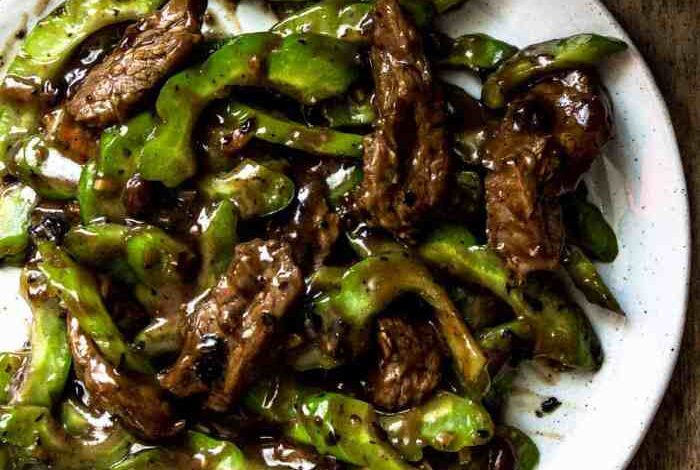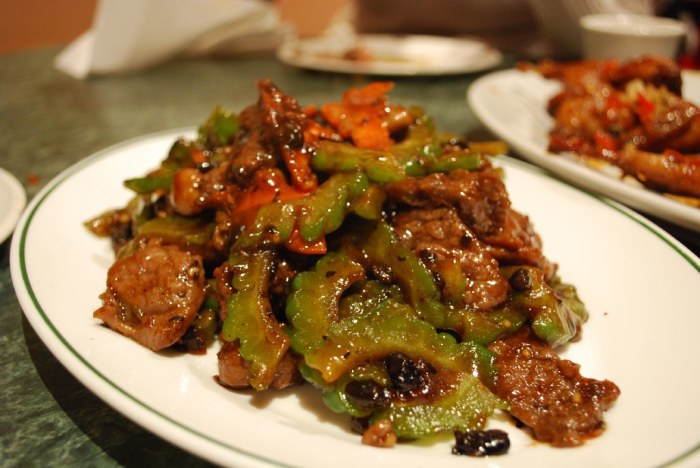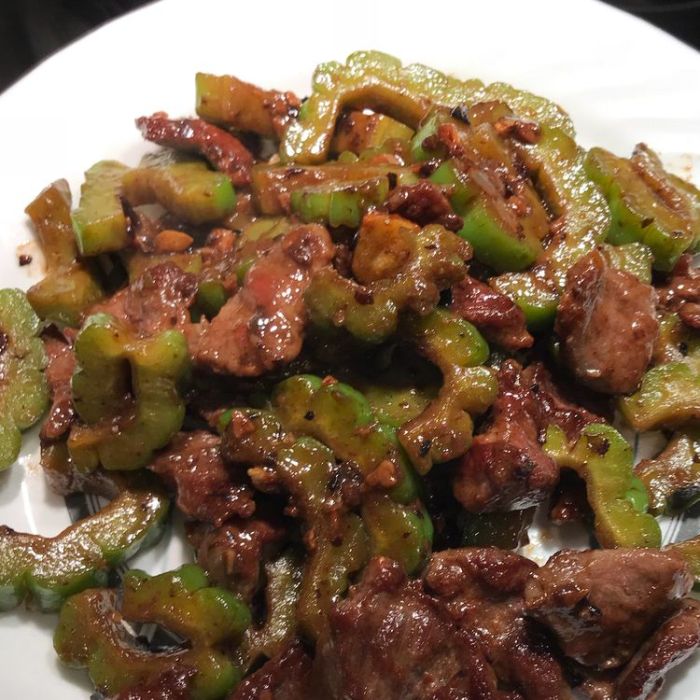
Bitter Melon and Black Bean Sauce Beef: A Flavorful Fusion
Bitter melon and black bean sauce beef is a dish that might sound unusual at first, but trust me, it’s a flavor explosion waiting to happen. This unique combination brings together the earthy bitterness of bitter melon, the savory richness of black bean sauce, and the tender, succulent texture of beef.
It’s a dish that’s sure to tantalize your taste buds and leave you wanting more.
The contrasting flavors and textures create a harmonious blend that’s both comforting and exciting. The bitter melon adds a refreshing element, while the black bean sauce provides a depth of flavor that complements the beef perfectly. It’s a dish that showcases the versatility of these ingredients and highlights the beauty of culinary fusion.
Bitter Melon

Bitter melon, also known as bitter gourd, is a tropical vine that produces a unique fruit with a distinct, intensely bitter flavor. This fruit has been a staple in many Asian cuisines for centuries, and its distinctive taste has captivated culinary enthusiasts worldwide.
Flavor Profile
Bitter melon’s flavor is characterized by its pronounced bitterness, often described as a combination of cucumber and green bell pepper, with a hint of earthiness. This intense bitterness is attributed to the presence of compounds like momordicin and charantin. While the bitterness can be overwhelming for some, others appreciate its unique flavor and find it refreshing and stimulating.
Traditional Uses
Bitter melon has a long history of use in traditional medicine and cuisine across various cultures. In India, it is believed to have cooling properties and is often used in curries and stir-fries. In China, it is used in traditional Chinese medicine to regulate blood sugar levels and treat digestive issues.
In the Caribbean, it is a popular ingredient in stews and soups.
Nutritional Benefits
Bitter melon is a nutritional powerhouse, packed with vitamins, minerals, and antioxidants. It is a good source of vitamin C, vitamin A, potassium, and iron.
- Antioxidant Properties:Bitter melon is rich in antioxidants, which help protect cells from damage caused by free radicals.
- Blood Sugar Regulation:Studies have shown that bitter melon may help regulate blood sugar levels by increasing insulin sensitivity.
- Anti-inflammatory Properties:The anti-inflammatory properties of bitter melon may help reduce inflammation in the body.
- Immune System Support:Bitter melon contains compounds that may boost the immune system.
Recipes
Bitter melon’s versatility allows it to be incorporated into a wide range of dishes. Here are a few examples:
- Stir-Fried Bitter Melon with Beef:This classic Chinese dish combines the bitterness of bitter melon with the savory flavor of beef, creating a balanced and flavorful meal.
- Bitter Melon Soup:This light and refreshing soup is a popular choice in Southeast Asia. It is often made with chicken or pork broth and seasoned with ginger, garlic, and fish sauce.
- Bitter Melon Pickles:In some cultures, bitter melon is pickled to reduce its bitterness and create a tangy and crunchy snack.
Black Bean Sauce
Black bean sauce is a staple ingredient in many Asian cuisines, adding a rich, savory, and slightly sweet flavor to dishes. Its unique flavor profile comes from a complex blend of fermented black beans, spices, and other ingredients.
Bitter melon and black bean sauce beef is a dish that always brings back memories of family dinners. The bitter melon adds a unique flavor that I find strangely addictive, and the black bean sauce adds a depth of flavor that I love.
It’s a dish that’s easy to make and always a crowd-pleaser. I often pair it with a simple side of rice, but I also love serving it with a whole chicken in a pan, like the one I found on this website.
The combination of the savory beef and the juicy chicken is just perfect.
History and Origins
Black bean sauce has a long history, dating back centuries in China. Its origins can be traced to the ancient practice of fermenting black beans, a process that enhances their flavor and creates a savory umami taste. The exact origins of the sauce are debated, but it is believed to have emerged in the Sichuan province of China, where fermented black beans are a common ingredient.
Over time, black bean sauce spread throughout China and eventually made its way to other parts of Asia, becoming a popular condiment and ingredient in various cuisines.
Key Ingredients and Flavor Profile
The primary ingredient in black bean sauce is fermented black beans, which provide the sauce’s signature umami flavor. Other common ingredients include:
- Soy sauce: Adds saltiness and depth of flavor.
- Sugar: Contributes sweetness and balances the savory notes.
- Spices: Often include star anise, cloves, and cinnamon, which create a warm and aromatic flavor profile.
- Garlic and ginger: Add pungent and aromatic notes.
- Chiles: In some varieties, chili peppers provide a spicy kick.
The combination of these ingredients creates a complex and savory flavor profile that is both umami and slightly sweet.
Bitter melon and black bean sauce beef is a dish that always reminds me of my grandma’s cooking. The sweet and savory flavors are just so comforting. It’s a great dish to serve with rice, but it’s also really good with noodles.
If you’re looking for something a little more adventurous, you might want to try Mississippi beef short ribs , which is a dish that’s both savory and smoky. But for me, there’s nothing quite like a plate of bitter melon and black bean sauce beef to make me feel right at home.
Types of Black Bean Sauce
There are several types of black bean sauce available, each with its own unique flavor profile and applications:
- Regular Black Bean Sauce:The most common type, with a balanced savory and sweet flavor. It is versatile and can be used in various dishes.
- Spicy Black Bean Sauce:This type contains chili peppers, which add a spicy kick to the sauce. It is perfect for adding heat to dishes.
- Thick Black Bean Sauce:This sauce has a thicker consistency than regular black bean sauce, making it ideal for stir-fries and marinades.
- Sweet Black Bean Sauce:This type has a higher sugar content, resulting in a sweeter flavor profile. It is often used in sweet and savory dishes.
Applications of Black Bean Sauce, Bitter melon and black bean sauce beef
Black bean sauce is a versatile ingredient that can be used in various dishes:
- Stir-fries:Black bean sauce is a classic ingredient in stir-fries, adding a savory and umami flavor to the dish.
- Noodles:It is often used in noodle dishes, such as chow mein and lo mein, providing a rich and flavorful sauce.
- Meat dishes:Black bean sauce is frequently used to marinate and glaze meat, such as pork, chicken, and beef. It adds a savory and caramelized flavor to the meat.
- Vegetables:It can be used to flavor vegetables, such as stir-fried green beans or bok choy.
- Dim sum:Black bean sauce is a popular ingredient in various dim sum dishes, such as dumplings and buns.
Beef

Beef is a versatile protein source that adds richness and depth of flavor to stir-fries. The key to achieving tender, flavorful beef in this dish lies in selecting the right cut and employing proper preparation techniques.
Beef Cuts Suitable for Stir-Fries
Choosing the right cut of beef is crucial for a successful stir-fry. Thinly sliced cuts cook quickly and evenly, ensuring a tender and juicy final product. Some popular cuts for stir-fries include:
- Sirloin Tip:This cut is lean and flavorful, making it a good choice for stir-fries. It can be sliced thinly against the grain for optimal tenderness.
- Flank Steak:Flank steak is a flavorful and versatile cut that benefits from marinating. It can be sliced thinly across the grain for a tender and juicy result.
- Beef Tenderloin:This cut is known for its exceptional tenderness and mild flavor. It can be sliced thinly for a luxurious stir-fry.
- Ribeye:Ribeye is a flavorful and marbled cut that can be sliced thinly for a rich and satisfying stir-fry.
Proper Beef Preparation for Stir-Fries
Proper preparation techniques are essential for tender and flavorful beef in stir-fries.
Bitter melon and black bean sauce beef is a dish that always reminds me of my grandmother’s cooking. The contrasting flavors, the slightly bitter melon, and the rich, savory sauce were a symphony of tastes. Speaking of contrasting flavors, have you ever tried chicken and mushroom crepes ?
The delicate crepe, the savory chicken, and the earthy mushrooms create a lovely combination. But for me, nothing beats the hearty warmth of bitter melon and black bean sauce beef on a cold day.
- Slicing:Slice the beef thinly against the grain for optimal tenderness. This allows the muscle fibers to break down easily during cooking.
- Marinating:Marinating the beef adds flavor and helps tenderize the meat. A simple marinade of soy sauce, ginger, garlic, and cornstarch is a good starting point. Allow the beef to marinate for at least 30 minutes, or up to overnight, for optimal flavor development.
- Tenderizing:Tenderizing the beef is crucial for achieving a tender and juicy final product. This can be achieved through marinating, using a meat tenderizer, or by pounding the meat with a mallet.
Cooking Methods for Beef in Stir-Fries
Beef is typically cooked quickly over high heat in a stir-fry. This ensures the meat retains its juices and develops a flavorful sear.
- Stir-frying:This is the most common method for cooking beef in stir-fries. The beef is cooked quickly in a hot wok or skillet, ensuring a tender and flavorful result.
- Pan-frying:This method is similar to stir-frying, but the beef is cooked in a flat pan instead of a wok. This is a good option if you don’t have a wok.
- Grilling:Beef can also be grilled for a smoky and flavorful stir-fry. It’s important to cook the beef quickly over high heat to prevent it from drying out.
Combining Flavors

The marriage of bitter melon and black bean sauce beef is a testament to the magic of contrasting flavors. The bitter melon, with its distinct, almost medicinal taste, serves as a counterpoint to the rich, savory notes of the black bean sauce.
This interplay creates a symphony of taste that is both complex and satisfying.
Flavor and Texture Interplay
The bitterness of the bitter melon, while initially striking, provides a refreshing contrast to the richness of the black bean sauce and the tenderness of the beef. The sauce, typically made with fermented black beans, soy sauce, and spices, adds a deep umami flavor that complements the bitterness of the melon.
The texture of the dish is equally intriguing. The crispness of the bitter melon, often stir-fried until slightly tender, provides a welcome textural contrast to the soft, succulent beef.
Balancing Flavors
Achieving a harmonious blend of flavors in this dish requires a delicate touch. The key is to balance the bitterness of the melon with the savory richness of the black bean sauce.
- Adjusting the Bitter Melon:The bitterness of bitter melon can vary depending on the variety and maturity. For a milder flavor, use younger, smaller melons or remove the seeds and pith before cooking.
- Adding Sweetness:A touch of sweetness can help to balance the bitterness of the melon. You can add a teaspoon of sugar or honey to the sauce or sprinkle a bit of brown sugar over the bitter melon before cooking.
- Using a Richer Sauce:A richer, more flavorful black bean sauce can help to offset the bitterness of the melon. Look for a sauce with a higher concentration of black beans and a robust flavor profile.
Recipe for Bitter Melon and Black Bean Sauce Beef
This recipe yields a delicious and flavorful dish that showcases the unique combination of bitter melon and black bean sauce.
Ingredients:
- 1 bitter melon, halved lengthwise, seeded, and thinly sliced
- 1 pound beef, cut into thin strips
- 1 tablespoon cornstarch
- 1 tablespoon soy sauce
- 1/2 teaspoon black pepper
- 1 tablespoon vegetable oil
- 1/2 cup black bean sauce
- 1/4 cup water
- 1/2 teaspoon sugar (optional)
Instructions:
- Marinate the beef: In a bowl, combine the beef, cornstarch, soy sauce, and black pepper. Mix well and set aside for at least 15 minutes.
- Prepare the bitter melon: Heat the vegetable oil in a wok or large skillet over medium-high heat. Add the bitter melon slices and stir-fry for 2-3 minutes, or until slightly tender. Remove from the pan and set aside.
- Cook the beef: Add the marinated beef to the wok and stir-fry for 2-3 minutes, or until browned.
- Add the sauce: Stir in the black bean sauce, water, and sugar (if using). Bring to a simmer and cook for 1-2 minutes, or until the sauce thickens slightly.
- Combine and serve: Return the bitter melon to the wok and stir to combine. Cook for another minute, or until heated through. Serve immediately over rice.
Serving Suggestions
This flavorful dish is best enjoyed with complementary sides that enhance its unique taste profile. Here are some ideas for accompaniments and presentation to make your Bitter Melon and Black Bean Sauce Beef truly shine.
Side Dish Suggestions
The bitter melon and black bean sauce beef pairs well with a variety of side dishes that offer contrasting textures and flavors. Here are some suggestions:
- Steamed Rice:A classic accompaniment that absorbs the savory sauce and provides a neutral canvas for the bold flavors of the dish.
- Noodles:Thin rice noodles or egg noodles offer a light and satisfying counterpoint to the meat and bitter melon.
- Stir-Fried Vegetables:A medley of colorful vegetables, such as broccoli, bell peppers, and onions, adds freshness and a touch of sweetness to the dish.
- Simple Salad:A crisp salad with a light vinaigrette helps to cleanse the palate and provide a refreshing contrast.
Garnishing Ideas
A few simple garnishes can elevate the visual appeal of your Bitter Melon and Black Bean Sauce Beef. Consider these options:
- Fresh Herbs:A sprinkle of chopped cilantro, basil, or mint adds a touch of freshness and aroma.
- Sliced Green Onions:The sharp flavor and vibrant green color of green onions complement the dish nicely.
- Sesame Seeds:Toasted sesame seeds provide a nutty flavor and a textural element.
- Red Chili Flakes:For those who enjoy a bit of heat, a pinch of red chili flakes adds a fiery kick.
Serving Temperature
Bitter Melon and Black Bean Sauce Beef is best served hot, allowing the flavors to meld and the sauce to become rich and glossy. Serve immediately after cooking for the optimal experience.
Variations
This dish is highly adaptable and can be customized to suit individual preferences and regional variations. Here are some examples:
| Variation | Description |
|---|---|
| Szechuan Style | The addition of Szechuan peppercorns and chili peppers creates a spicy and numbing sensation. |
| Hunan Style | A combination of ginger, garlic, and fermented black beans adds a pungent and savory flavor. |
| Cantonese Style | This version often incorporates oyster sauce and a touch of sweetness. |
| Vegetarian Option | Replace the beef with tofu or mushrooms for a plant-based alternative. |
Cultural and Regional Variations: Bitter Melon And Black Bean Sauce Beef
Bitter melon and black bean sauce beef, while a beloved dish across many Asian cultures, exhibits fascinating variations based on regional preferences and culinary traditions. This exploration delves into the diverse interpretations of this dish, showcasing how cultural influences shape its ingredients, preparation methods, and overall flavor profile.
Regional Variations
Across Asia, the dish showcases regional variations, with each region adding its unique touch. For example, in China, the dish is often stir-fried with garlic, ginger, and chilies, resulting in a fiery and aromatic flavor. In contrast, the Thai version might incorporate fish sauce and lime juice, adding a tangy and slightly sweet element.
Similarly, in Vietnam, the dish often features lemongrass and cilantro, contributing a fresh and fragrant profile.
Cultural Influences on Ingredients and Preparation
The diverse cultural influences are evident in the ingredients and preparation techniques. In Chinese cuisine, the use of black bean sauce, a fermented soybean paste, is prevalent, adding a savory and umami depth to the dish. In Thai cuisine, the use of fish sauce, a fermented fish product, imparts a salty and umami flavor.
Similarly, in Vietnamese cuisine, the use of lemongrass, a fragrant herb, contributes a citrusy and herbaceous note.
Anecdotes and Stories
The dish’s history is interwoven with stories and anecdotes that highlight its cultural significance. In China, the dish is believed to have originated in the Sichuan province, where it was traditionally served as a peasant dish. The dish’s affordability and nutritional value made it a staple food for the working class.
In Thailand, the dish is often served at street food stalls, reflecting its accessibility and popularity.
Visual Representation of Cultural Context
Imagine a visual representation of this dish’s cultural context, perhaps a stylized illustration depicting a bustling street food market. The image would showcase diverse stalls selling variations of the dish, each representing a specific region. The illustration would also incorporate traditional ingredients, such as bitter melon, black beans, and chilies, visually highlighting the dish’s cultural diversity.






